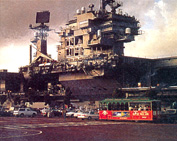
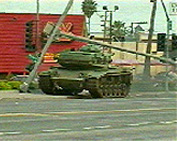
The Importance of San Diego >>
In San Diego, this "complex" gains a special meaning. Tourist pamphlets emphasize its importance as a "Navy town" by offering various sightseeing tours inviting us, for example, to "Join Old Town Trolley Tours as we show you one of the largest military complexes in the world."(3) The location of the conference seems to have been quite deliberately chosen with respect to this specific economic, political, geographical and social constellation. The Mexican border is nearby; in fact, it can be reached by local trolley. Restricted military areas abound within the town and around it, the monuments for fallen soldiers cannot be missed, and the Navy dominates the architecture of the area with the living quarters for the families of enlisted and retired army personnel. There is a lot of overlapping with the civilian world, as there is, for example, in academia. The UCSD (University of California San Diego) tends to inherit professors who have terminated their posts in military institutions, especially if their area of research embraces the new media. Local bookstores demonstrate a gender-specific manifestation of the influence of the military complex. The "women's" section offers paperbacks on Lady Diana or fantasy novels. But there is also a special section for "men", which holds oversized picture documentaries on the military, books on military history and reports on "Operation Desert Storm" and the operation in Bosnia.
A further characteristic incident that comes to mind is the story of the driver who ran amok and found his fifteen minutes of fame and international press coverage in 1995 by stealing a tank and driving it over the highway, crushing several cars and houses along the way. The man had been trained as a tank-driver and then let go in the wake of the so-called "downsizing" of the military, which involved budget-cuts and staff reductions.(4)
 |  |
| "Military Tour Information: Join Old Town Trolley Tours as we show you one of the largest military complexes in the world." (5) | 18-05-95: "This is war." (6) |
These varied impressions are supported by the facts and figures documented in the Internet(7) concerning the status of the military in San Diego. Despite a staggering reduction of national defense expenditure since 1990, San Diego has retained its importance as a decisive center of activity.(8)
Nevertheless, the decisive measures of military downsizing have already brought about significant changes. Starting in 1990, California has experienced a rise in unemployment that is proportionally much higher than in the rest of the United States and still lies above average.(11) The most drastic cuts concern the field of the aerospace industry, affecting the whole of the economy in California. Many highly paid posts in military high technology have been eliminated, and the turnover of the local contracted industry has also come to a standstill. The transition to the civilian market potential has already been made in many areas, especially with regard to information technology, such as high-tech medicine. This development is in concert with the policies of the Defense Department. The "Dual-Use-Act" outlines the intentions of the Defense Advanced Research Projects Agency (hereafter referred to as its acronym, DARPA) of preferably financing research projects that can also be implemented into civilian health projects. This means a major transfer of technology: decades of military-technological knowledge will be poured into the area of medicine, also as a means of stabilizing the job situation in the shaky military industry.
In another initiative currently supported by the government, the Trade and Commerce Agency of California offers, under the heading "Areas of Opportunities," cheap openings for "venture capitalists" interested in profiting from the existing concentration of over 200 companies in the area of San Diego that concern themselves with new technology. Biotechnology, defined as "techniques that use living organisms or their components to make products",(12) is promoted as the technology of the future.
The Conferences>>
This special regional situation which already demonstrates an economic shift from military to civilian high technology, with a special emphasis on biomedicine, was not, however, the subject of these conferences. No attempts were made, whether in the papers read or in the discussions that followed, at questioning so-called "dual-use" in military and civilian matters, as, for example, in the dubious militarization and technologization of medicine. On the contrary, the general attitude was global and optimistic. On the horizon, if not squarely at the center of many presentations, stood not only the future of the American Healthcare System, but also the future of the Earth and even of mankind itself. On the other hand, a large proportion of the speakers came from San Diego and California, working in research or as businessmen in the area of technology, and there was one military reference which popped up repeatedly: medical care on the battlefields of the future. The question of who should attend these conferences was answered in both cases with an almost identical list of professions: "Physicians, Surgeons, Roboticists, Information Scientists, Medical Technologists, Biotech Entrepreneurs and Researchers, Biomedical Professionals, Medical Technologists, Venture Capitalists and Corporate Futurists, (...), anyone interested in the future of medicine and biotechnology." However, that in itself does not explain the many highly polished patent leather shoes that seem to belong to the staple wardrobe of the US military and which remained astonishingly motionless on the thick carpets of the lobby and the "ballrooms" of the hotel that had been converted into conference rooms.
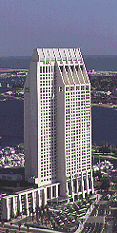 |
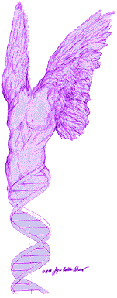
|
| Conference location: "Standing at 40 stories, the Hyatt Regency San Diego is the tallest waterfront building on the West coast." (14) | "Medicine is Art. Medicine is supported by Science. Medicine is enabled by Technology." (15) |
Here I would like to invite you on a quite subjective "guided tour" of subject matter that seemed to me to emerge as a "military-medical complex" during my attendance at the conferences. The broad scope of this tour mirrors the broad concept of the conferences, which promised, under an enlisted trademark, nothing less than a definition of the future of mankind - a better, safer, healthier future. The starting point of our tour will be the Sixth Annual Conference on "Medicine Meets Virtual Reality™", which labels itself as the first international forum for the interfacing of medical and interactive technologies as a guarantee for "creating the future of healthcare."(16) The organizers' description of the conference spares us no superlatives; its achievements are offered for consumption:
The titles and subtitles of the two overlapping conferences set the pace for the phrasing of theses, queries and goals. The protection of the titles by trademark is the first thing that catches one's eye. Obviously, words are viewed here as trademarks, part of a business transaction. "Medicine is Art" can be seen as the declaration of a program, a prophecy which is self-fulfilling in the sense that the art of product-marketing is an important element in its implementation.
The protection of labels by trademark, labels that contain a reference to the vocabulary of social visionaries, seems to suggest that the correct word at the right time is worth gold and can influence important decisions. Since the speeches all followed a similar tendency, it was possible, without exaggeration, to mentally attach a small "™" to every one of the words read from the papers. In this context, words seemed to convert themselves into instruments of a sales strategy, quite apart from the substantial costs of attendance, up to US$ 630 per conference. Following the argumentation of the conferences, one could see them as "instruments of information." In endless repetition, introductions and closing speeches maintained that "the future of healthcare is information."
Information, as we have seen, that sells and can be sold. The object was information technology and the preparation of the market, or, as the guiding principle of the conferences loftily maintained, "Information Heals." This "Healthcare(R)evolution™," the (R) in parentheses implying that the future positive development of the healthcare system in the US will evolve as naturally as the species, would like to diminish the exploding costs and inadequacies of the healthcare system by investing in a wide range of information technologies.
The meaning of the word "information" in healthcare varies in quality, ranging from self-help-groups that exchange their views through the Internet, to chip-cards for the extensive electronic registration of patient records, to progress in the deciphering of the human genome. "Information" also stands for health education in the widest sense. Thus, the question mark in the title of the conference "NextMed: The End of Healthcare?" does not indicate a critical evaluation of the possible collapse or financial ruin of healthcare in the US, but rather takes a positive stand concerning the future. The main idea, reiterated endlessly, proclaimed that a new concept of healthcare could reduce a large proportion of the costs in the healthcare system, for example, through the reduction of direct contact with doctors. How can this vision be reconciled with qualitative improvement in healthcare? For clarification, statistics are cited that seem to prove the extreme inefficiency of the current system: 50 to 80 percent of all people that consult a doctor are in no need of medical help. 70 to 80 percent of all health problems can be fixed at home, if one knows what to do. Not a lot remains to be treated.(19) The remaining cases that require healthcare for recognized, more or less "objective" health problems would, as several lectures demonstrated, be eliminated through the intervention of genetic engineering against, for example, aging or cancer.(20) The ideal of everlasting health for all was held forth in all seriousness as the "happy end" of the development of "healthcare," with genetic engineering defined as a force of the near future with reference to promising animal experiments. "Thought - Health - Immortality": the conference program of NextMed phrases this perspective as follows:
What are the linguistic and philosophical consequences of this simple and efficient maneuver? The goal seems to be nothing less than the elimination of that which has hitherto been seen in social, cultural and judicial traditions as the Subject. The "I" is seen as qualitatively equivalent to the information that can, e.g., be interpreted as genetic individuality from a strand of hair. The complex process of acquirement and criticism of knowledge, previously known as science and interpreted as cultural work, is being abolished by a concept of information that defines "information" as real, effective, successful information.
The prefix "Bio-" preceding the evolutionary revolution through "information" is relinquished as well in its function as the representation of resistance, e.g., in the diction of ecology or politics. "Bio-" represents the genetic information or medical data in simulated environments. Their "realization", as through cloning, is also seen as "information." The pompous slogans of the conference Medicine Meets Virtual Reality must be read as such: "Medicine is Art" - an assertion that gains its full significance through the fact that art and culture in the traditional sense no longer exist. "Medicine is supported by Science" - an astonishing claim, since medicine itself used to be seen as a science. Here, however, medicine has surpassed science and become the regent over "information" and life. And pays its dues to the hardware that made this status of power over life and the world possible: "Medicine is enabled by technology." Technology, it goes without saying, is based on computers. Here I would like to illuminate two projects, or focuses of research, as representative examples of the interaction and realization of such "information" in a non-lingual area that will also allow some definitive conclusions. The first is concerned with the long-term attempts to introduce telepresence technology into the medicine of the future.
Telepresence systems stand for a certain concept of virtual reality. A robot instrument is directed from a distance and can be instructed to perform certain tasks. In order to know which commands can be issued effectively, it is important to transmit a representation of the environment that will be manipulated, if possible in real-time, to the site of the person issuing the commands. Traditional areas of research are the manipulation of dangerous substances from a safe distance, radioactive radiation or unmanned operations in space or surgical interventions over a large distance, as for example when supplying the far-off theaters of war.
The second project I would like to introduce comprises the grandest attempt at visualizing medical data: the "Visible Human Project™" of the National Library of Medicine (USA). The three-dimensional virtual representation of the body that is here being concocted and defined as a "realistic" representation of the body will also offer a novel technological "model" of the human body for future medical telepresence operations. Both projects are conceptually and technically compatible - like a main-frame computer and its peripherals, like hardware and software.
Telepresence>>
Telepresence combines the Greek prefix "tele-" (remote) with presence, resulting in a "remote presence" - a novel, split form of existence.
The term "telepresence" was coined 1969 at the Massachusetts Institute of Technology (MIT), by Marvin Minsky, Professor of Artificial Intelligence. His text "Towards a Remotely-Manned Energy and Production Economy" offers the following illustration of the concept:
This kind of artificial self-reference might lead to some confusion: Where is "here"; when is "now"? The necessity of finding an answer to such questions may seem absurd, but not more absurd than another problem that inevitably crops up: Where does my, or another's, body end? What is the significance of the image data that is sent from the operating point in correlation to the spatial notation of motion?
What were introduced in 1969 as sensors that could be used for visual, audio and tactile feedback, or as "hands" that could operate at a distance, have since been implemented into many products and were presented at the conference in various mutations. For example, a DARPA project, developed by Spawar Systems Center, demonstrated the so-called "Sensate Liner for Combat Casualty Care": a computer in the guise of a T-shirt for soldiers, containing a "Global Positioning Tracking System", which enables the localization of its wearer within an area of three feet (one meter). Software that is woven into the shirt as electricity-conducing, encoded threads can calculate the path of a projectile and estimate which of the soldier's organs might be wounded. The optical sensors of the T-shirt can color-analyze the blood coming from a wound and define its venal and arterial components. Audio sensors compute the data for a prognosis of the velocity and size of the intruding projectile. Data on respiration, blood pressure and pulse are transmitted, as well as physical data on movement or standstill and information on the environment, such as air temperature. The processor and transmitter are attached to the fabric of the shirt in the form of a small electronic package. If we compare this portable computer to Minsky's remote-operating "hands" from 1969, one could say that these hands have now metamorphosed into a T-shirt and gained the ability to differentiate remote perceptions that can be delivered to supervising physicians in the form of image, sound and diagrams.
This development allows for the permanent connection of primarily a soldier's body to the universalized concept of telepresence. Another project has set itself the goal of optimizing the telepresence operation of endoscopic instruments of surgery. In this case, the patient is already lying under the remote-controlled surgeon's "hands." The "Computerized Endoscopic Surgical Grasper" from the University of Washington was conceived towards the improvement of tactile feedback during remote surgeries. An automated function allows the grasper to independently analyze the mechanical attributes of certain tissues by applying different types of pressure, thus identifying the small intestine, lungs, spleen, liver, colon and stomach. Haptic differentiation of sick and healthy tissue is already being developed.(23)
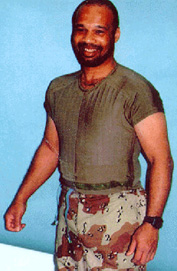 | 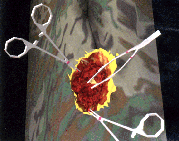 |
| "Smart Shirts ...Might Just Save Your Life - In the wars of the new millennium, soldier's wounds will be digitally diagnosed" (24) | "Because surgery simulation is a nascent technology, the Uniformed Services University of the Health Sciences will initially function as a test bed to evaluate the performance of VR medical training systems."(25) |
An important factor of a telepresence system is the visualization of the objects that the sensors "touch" and "see" at some remote location. This is most obvious in three-dimensional simulations - visualizations shown via Head Mounted Displays as well as different types of Shutter-glasses that are getting smaller and lighter all the time. Even a laser ray that projects the image directly into the eye, on the retina, without using a display ("Virtual Retinal Display") is conceived as a realistic possibility. A pictorial "realism" of these visualizations in the sense of high-definition and photographic image quality is not the primary aim, since that would entail an immense delay for the computing involved. Even visualizations that may at first sight seem primitive, reminiscent of gray shadows or multicolored tinker toys, enable the actual execution of complex manipulations. The operators of these telepresence systems often describe this as a novel experience, connecting the impressions of reality with a feeling of "presence." The decisive factor seems to be the changes in the three-dimensional pictorial world following the movements of head and hands. The motion of one's own hand (in a data glove or a mechanical manipulation system) directs the same motion in the image of a hand. Turning your head means that the angle of the images shown changes as well, and if one lowers an instrument, its image in the artificial scene is also lowered. One thing remains obvious: the movement that is viewed is different than that which is enacted. What is perceived in a telepresence system does not correspond to what has been done, nor to the execution of the remote units. Bluntly said: I cannot see what I do. However, each user feels the need to reconstruct himself as an operating subject from the synchronicity perceived through motion, and to interpret this temporal correlation as a guarantee of a temporarily and pragmatically donned identity.
With respect to the object operated on, telepresence surgery signifies that every operation is performed on an "image," with, in this case, life-defining consequences for the person portrayed. One cut into these novel "body-images" can be seen both as a computing process and as a cut into a living body.
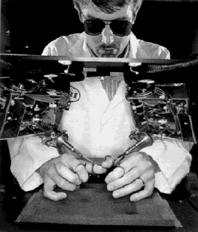 | 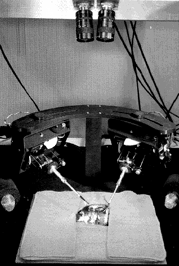 |
| "Using modern telemanipulator, control, and imaging capabilities, we have developed systems, that enable the full spectrum of surgical tasks - such as cutting, suturing, and dissecting - normally performed by surgeons." (26) | "Improvements to expand the interface to two hands and interaction with a more realistic tissue model are under way."(27) |
A film scenario produced by the US Defense Department in 1994 (28) already shows how wounded soldiers are found and diagnosed electronically, then transported by their fellow soldiers to the surgery container, where a nurse arranges them under the surgery robot in such a way that a specialist can operate the robot from a safe distance in order to extract the projectile and stitch up the wound. The lasting impression is one of precise work done on a sort of construction kit which, in this case, is the body of the soldier.
Taking into consideration that a satellite transmits the hand-motions of the surgeon as encoded data to the instruments working on the body of the wounded - doesn't this scenario seem to integrate space, Earth and the body of the soldier into one virtual and actual battlefield? A battlefield which is itself transformed into a new, immeasurable "body" made out of bones, flesh and data, which can no longer be visually represented. Computerized image-production thus also touches on such established categories as fiction or documentary, the previously fixed distinction between the visible and the invisible, or between life and death.
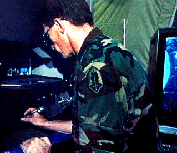 | 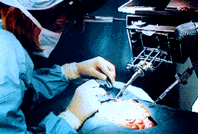 |
| "The system is engineered so that the surgeon actually feels as if the surgery were being performed directly in front of him, when in reality the remote site (and patient) could be yards, miles, or even hundreds of miles away." (29) | "Because the system was designed to mimic open surgery, there will be essentially no training required."(30) |
As is usually the case, the qualitative transformation and extension of the possibilities of image-production also serves to fuel an old desire which can be circumscribed as the "belief in the image." It is the belief that the domination of an image entails access to its reference in reality. This belief is certainly one inspiration for the non-differential use of the term of "information" at the conferences. The assertion that the transformation of the image-potential allows for a deeper penetration into the "Gewebe der Gegebenheit"(31) than ever before shall be further demonstrated through the case of the "Visible Human" project, as follows. Many of the lectures at both conferences contained references to this project.
The "Visible Human Project™">>
The "Visible Human Project" has gained prominence in many respects. Its portrayal in newspapers, magazines, television documentaries and websites, as well as scientific conferences, defines it as the most advanced and enhanced attempt at visualizing medical data. Astonishingly enough, the main interest of popular as well as scientific reports seems to be the endlessly repeated idea of a transition: from a living organism to an oddly "living picture." The choice of words reminds us of the one-time belief in the potential of cinematography. Among the early definitions of cinematographic technology, we find terms such as "bioscope," "biograph," "living photographs" and "living images." I would like to pursue this misinterpretation of visualized "life" in the current example of the "Visible Human."
The "Visible Human" was conceived by the US National Library of Medicine. An essential aim of this organization is the establishment of medical imaging databases that can be accessed through high-tech computer-nets. The long-term goal is the establishment of an extensive "Digital Image Library" connecting medical image and text-based information, prepared as a knowledge base and structured as hypermedia. This entails the evaluation of visual information data that has been segmented by experts. Segmented - i.e., the recognition and marking of the outlines of bones, muscles and organs in the images of computerized tomography - in order to allow the organization of the anatomic specification of each identifiable image, according to the text-markings, as "visual knowledge."
The first project on the long walk to the "Digital Image Library" was the "Visible Human," commissioned in 1986. This digital archive of a visible human necessitated the registration of the data-volume of a "complete, normal adult male and female"(32) through digitized photographic images for cyrosectioning, digital images derived from computerized tomography and digital magnetic resonance images of cadavers. This data was acquired over the last five years by computer scientist Victor Spitzer and anatomist David Whitlock at the Health Sciences Center of the University of Colorado. The data-set of the male cadaver was completed first and named "Adam."
 |  |
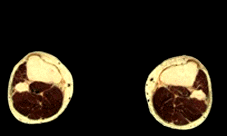 | 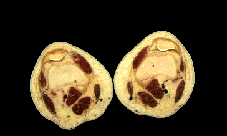
|
| "Adam"(33) | "Eva"(34) |
Heralded as the "first digital description of an entire human being"(35), the "Visible Human male" stands not only for one male cadaver, but is quite casually also seen as a novel definition of the "entire human being." The aim of representing a complete "human being" in a digital image library may seem astonishing and is, clearly, theoretically impossible, since the values tend toward the infinite. The practical aim is, of course, a high degree of technological precision and completeness in the registration of images, with a data-set that is as large as possible in order to guarantee a high optical image resolution.(36)
However, the amount of data was not what made the "Visible Human Project " famous. The images of the cadavers were represented in print media and television reports as something quite different: namely, as the "fantastic creation of the first (real) digital human being."(37) The supposed "life" of this data made headlines. The data-set "Adam" was described in a biblical sense as a kind of repetition of creation, as the resurrection of dead matter. Newspapers and television defined the whole project as a revitalization, the electronic "resurrection"(38) of a dead body as if a person might be able to "live on" in the form of complete, extensive and identical data in the computer. The quest for completeness in the registration of image data is transformed into the belief in the complete identity of the image and the portrayed, as if one were the identical double of the other. Images are thus seen as clones.
During recent years, scientists have been working on the data to produce increasingly "realistic" simulations that enable numerous three-dimensional visualizations - the so-called "Virtual Human" - from the cyrosectioning photographic images. Future applications of the data-set "Adam" include the implementation of "virtual" motion, in order to attain the active and passive simulation of motion.
The further manipulation of the data-set "Adam" has the long-term goal of offering Virtual Reality environments that allow visual and tactile feedback and can be used for the simulation of surgery on the virtual human being. The high level of realism striven for would allow the simulation of the changing of shapes in the three-dimensional renderings, as well as a feeling for the mechanical resistance of different tissues while applying a virtual scalpel. This in part already existing hardware and software design of the "Visible Human" will be used in surgical training for the simulation of operations. The virtual "human" can be dissected and interactively manipulated at will, and subsequently its original form can always be perfectly reconstructed. The real cuts are "healed" through the programs of visualization; they disappear as the regular structure of volume-elements in the new virtual image tissue. The imagery is open to all gazes or virtual instruments, from any spatial point, it can be turned around or opened, or even, as a complete expansion towards the visual, entered like a tunnel. The imagery that is thus produced turns the "data-body" inside out.
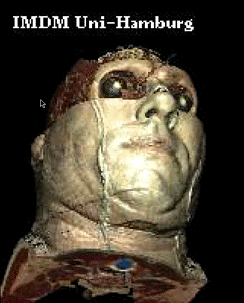 | 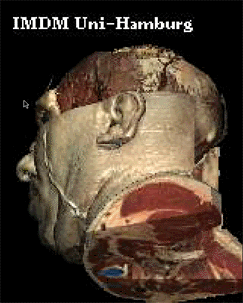 |
| "The real challenge is, however, the construction of a volume model of the Visible Human, which allows the interactive exploration and the derivation of labeled pictures and animations with realistic visualization. The VOXEL-MAN environment is ready for this." (42) | "Any visible object in an intelligent movie can be selected by a simple mouse click and related media like text, images, schemes, www-sites, or net-wide queries can be invoked locally or via Internet." (43) |
Practice is then possible on the individual. The data-set of the "Visible Human" can be linked to the specific data of a patient, thus enabling the simulation of a patient's body. This kind of computing, called "matching", is important since it allows a kind of representation that undermines the traditional distinction between a "model" and an "individual case." The "Visible Human, male" is simultaneously an individual body and a structured knowledge base, and in the same way, every male patient can be linked to the analyzed structure of this one virtual human and rendered according to his own specifications. In the surgical rooms of the future, the operation will be applied to the living patient with the same motions practiced in simulation. The condition is the telepresence transmission of surgery on the simulated body of the patient to a robot surgeon in the actual operating theater. Several plans for future surgery envision this kind of telepresence transmission in an actual environment as a normal procedure during surgery.(44)
In this light, the image definition of the "Visible Human Project" can be seen as a decoding and interpretation of information on human beings that was previously hidden in technical body-images. But not only can the structure of a digitized image now be analyzed and manipulated; the decoding of the image is itself seen as the blueprint of the object - of the human being - that can thus be diagnosed and manipulated. The surgery performed on this novel "body-image" is situated on a diffuse border between life and death, between the matter of a new imagery and the matter of the human body, namely within the concept of "information" - which now arrives at its technically precise meaning as a reference to a type of border.
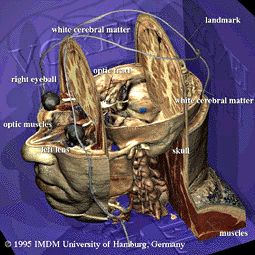
|

|
| "The surgery performed on this novel 'body image' is situated on an diffuse border between life and death, between the matter of a new imagery and the matter of the human body, namely within the concept of 'information'." | "Interactive classification in RGB-space for the left kidney: The user first outlines some typical areas of the kidney (left column). A preliminary result is obtained when all marked triples are used (middle). By restriction to the 'substantial' triples, the final sharp classification is computed (right)." (45) |
"The 5th Dimensional Human">>
These observations are intimately connected to the issues raised by one key lecture within both conferences, held by Colonel Richard M. Satava, one of the most renowned protagonists of tele-medicine and the implementation of Virtual Reality in medicine. In San Diego, he was introduced as the spiritual father of Virtual Medicine, and of these conferences. According to his biography, he now holds tenure as a Professor of Surgery at Yale University, following many years as a project manager at DARPA.
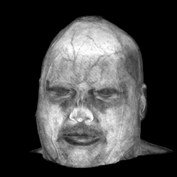 | 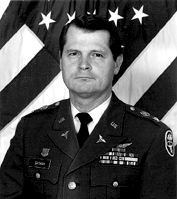 |
| "What you are looking at here is bits and bytes. Zeros and ones. But it is also a living, breathing, caring human being. This may well be a way to introduce the future to you... " (54) | "While striving to practice the complete discipline of surgery, he is aggressively pursuing the leading edge of advanced technologies to formulate the architecture for the next generation of Medicine: Medicine 2001." (55) |
Translation: Brigitte Helbling